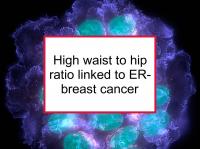A new prospective study has reported that while body fat distribution does not appear to play an important role in the overall incidence of premenopausal breast cancer, it is associated with an increased risk of estrogen receptor negative (ER-) breast cancer such as triple negative disease (ER-/PR-/HER2-).
Body mass index (BMI) has been reported to be inversely associated with risk of premenopausal breast cancer. Overweight premenopausal women are less likely to be diagnosed with breast cancer than normal weight women, but this relationship reverses after menopause, when being overweight is a risk factor for breast cancer. The underlying reasons for these associations are not well understood. Abdominal fat that surrounds organs is linked to metabolic and hormonal changes, many of which have in turn been associated with the risk of premenopausal breast cancer.
The study included 45,799 women in the Nurses’ Health Study II (a group of women who have been followed since 1989). Body fat distribution was assessed in 1993 by self-reported waist and hip measurements and waist to hip ratio. A total of 620 cases of breast cancer were diagnosed between 1993 and 2005 among the study participants.
Overall rates of breast cancer were statistically equivalent among women in the lowest fifth of waist circumference compared to those in the highest fifth. No significant associations were found overall between risk of breast cancer and waist circumference, hip circumference, or waist to hip ratio.
However, when analyzed according to hormone receptor status, each of the three body fat distribution measures was found to be significantly associated with greater incidence of estrogen receptor negative (ER-) breast cancer (a subtype which includes but is not limited to triple negative breast cancer). Premenopausal women with a high waist measurement, hip measurement, and/or waist to hip ratio were at least twice as likely to develop ER- breast cancer as women with low measurements.
The fact that body fat distribution was more strongly associated with ER- breast cancer than with ER+ breast cancer suggests that body fat may influence risk of breast cancer through pathways not involving sex hormones. In particular, the study authors comment that abdominal fat is associated with the increased levels of circulating insulin found in pre-diabetes.
Insulin receptors are expressed in most breast cancers and have been shown to stimulate the growth of breast cancer cells in the laboratory. “These findings may suggest that an insulin-related pathway of abdominal adiposity is involved in the etiology of premenopausal breast cancer,” according to the authors.
